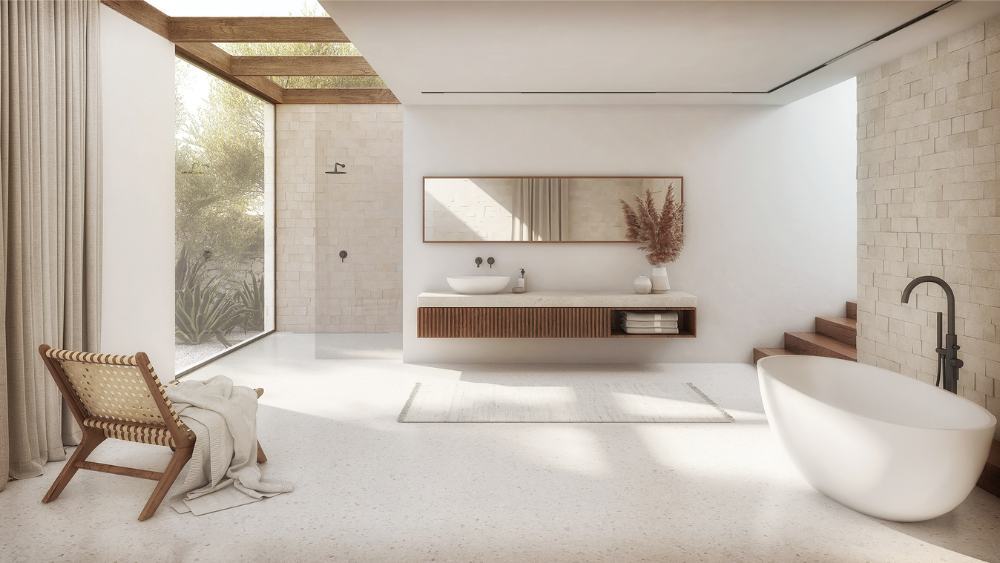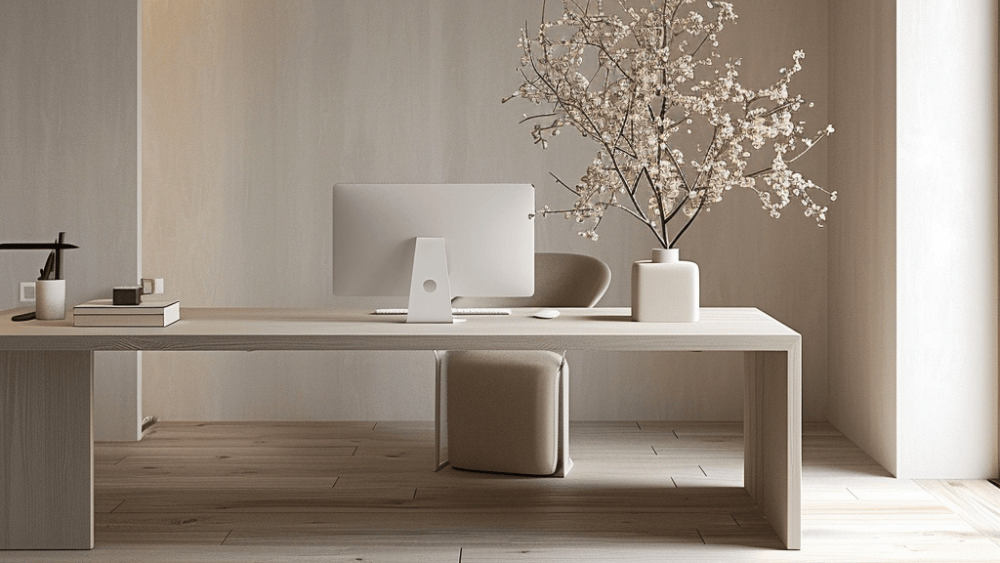Discover how to create a serene Japandi-style bathroom, blending Japanese minimalism with Scandinavian functionality for a tranquil retreat.
- Neutral color palette with natural materials like wood and stone
- Embrace wabi-sabi and minimalist design for uncluttered spaces
- Incorporate plants and water elements for a zen-like atmosphere
- Balance form and function with practical yet aesthetically pleasing fixtures
Transform your bathroom into a serene oasis by embracing the Japandi style, a harmonious blend of Japanese minimalism and Scandinavian functionality. This unique design approach creates a space that is both aesthetically pleasing and highly practical, perfect for those seeking a tranquil retreat in their own home.
Embracing the essence of Japandi bathroom design
At the heart of Japandi bathroom design lies a commitment to simplicity and natural beauty. This style marries the clean lines and functionality of Scandinavian design with the zen-like tranquility of Japanese aesthetics. The result is a bathroom space that exudes calm and serenity, while still being highly functional.
One of the key elements in creating a Japandi bathroom is the use of a neutral color palette. Think soft whites, muted greys, and gentle beiges as your base colors. These can be accented with subtle touches of muted greens, blues, or soft pinks to add depth and interest to the space. The goal is to create a soothing atmosphere that feels connected to nature.
Natural materials play a crucial role in Japandi design. Incorporate elements such as:
- Light woods like oak, ash, or beech
- Natural stone such as marble or granite
- Bamboo accents
- Organic cotton or linen textiles
These materials not only add visual warmth but also create a tactile experience that enhances the overall sensory appeal of the space. The use of natural materials also aligns with the Japandi philosophy of creating a connection to the natural world.
To truly capture the essence of Japandi style, embrace the concept of wabi-sabi - the Japanese philosophy that finds beauty in imperfection. This might mean choosing a slightly irregular handcrafted sink or incorporating a weathered wood element. The goal is to create a space that feels authentic and lived-in, rather than sterile and overly perfect.
Crafting a functional and minimalist oasis

The Japandi bathroom style emphasizes functionality and uncluttered spaces. This doesn't mean your bathroom should feel sparse or austere; rather, it should be thoughtfully designed to meet your needs while maintaining a sense of openness and tranquility.
Start by considering your storage needs. Opt for floating japandi vanities and shelves that provide necessary storage while maintaining a light, airy feel. Choose simple, streamlined fixtures that blend seamlessly into the overall design. A freestanding bathtub can serve as a stunning focal point, embodying both functionality and aesthetic appeal.
Lighting plays a crucial role in creating the right atmosphere. Maximize natural light wherever possible, as this aligns perfectly with the Japandi ethos of connecting with nature. For artificial lighting, choose soft, warm options that create a gentle glow. Consider:
- Pendant lights with natural materials like bamboo or wood
- Wall sconces that provide indirect lighting
- LED strips for subtle accent lighting
When it comes to bathroom layout, consider the principle of ma - the Japanese concept of negative space. Allow for open areas that create a sense of spaciousness and tranquility. This might mean opting for a walk-in shower instead of a bulky enclosed one, or choosing a compact toilet design to free up floor space.
Here's a simple guide to achieving a minimalist yet functional Japandi bathroom:
| Element | Japandi Approach |
|---|---|
| Vanity | Low-profile, floating design with natural wood finish |
| Mirror | Simple, frameless or thin wooden frame |
| Shower | Walk-in with glass partition, minimal hardware |
| Toilet | Wall-mounted or compact design |
| Storage | Hidden cabinets, open shelving with minimal decor |
Incorporating natural elements for a zen-like atmosphere
To truly capture the essence of Japandi style and create a zen-like atmosphere in your bathroom, it's essential to incorporate natural elements. This not only enhances the visual appeal but also promotes a sense of calm and wellbeing.
One of the most effective ways to bring nature into your Japandi bathroom is through the use of plants. Choose low-maintenance, low-light plants that thrive in bathroom environments. Some excellent options include:
- Spider plants
- Snake plants
- Bamboo
- Ferns
- Orchids
These plants not only add a touch of green to your space but also help purify the air, creating a fresher, more invigorating environment. Consider placing them on floating shelves, in corners, or even hanging them to maximize space.
Water elements can also play a significant role in creating a serene Japandi bathroom. While a full-scale water feature might not be practical, you can incorporate the soothing sounds of water through a small tabletop fountain or by choosing a rainfall showerhead for your shower.
Natural textures are another key aspect of Japandi design. Incorporate these through textured tiles that mimic stone or wood grain, woven baskets for storage, or textured towels and bathmats. These elements add depth and interest to the space while maintaining the overall minimalist aesthetic.
To further enhance the connection to nature, consider using organic shapes in your bathroom design. This might include a curved freestanding bathtub, round mirrors, or organically shaped sinks. These softer forms create a more relaxed, natural feel in contrast to the sharp angles often found in modern bathroom designs.
Balancing form and function in Japandi bathrooms
The true beauty of Japandi style lies in its ability to balance aesthetics with practicality. This harmony between form and function is what makes Japandi bathrooms not just beautiful, but also highly livable spaces.
When selecting fixtures and fittings for your Japandi bathroom, prioritize items that are both visually pleasing and highly functional. For example, choose a sink or basin made from natural stone like granite or marble. These materials are not only beautiful but also durable and easy to clean. Similarly, opt for faucets and showerheads with clean, simple lines that are easy to use and maintain.
Storage is another area where form and function must be carefully balanced. While the Japandi style emphasizes minimalism, it's important to ensure you have adequate storage for all your bathroom essentials. Consider:
- Built-in cabinets with simple, handleless designs
- Open shelving for displaying carefully curated items
- Hidden storage behind mirrors or under floating vanities
- Woven baskets for a touch of texture and practicality
When it comes to bathroom textiles, choose items that are both beautiful and functional. Opt for high-quality, absorbent towels in muted, earthy tones. Consider using linen shower curtains which are not only aesthetically pleasing but also naturally mold-resistant and quick-drying.

Lighting in a Japandi bathroom should be both practical and atmospheric. Install task lighting around the japandi mirror for grooming activities, but balance this with softer, ambient lighting to create a relaxing atmosphere for bathing. Consider using dimmable lights to allow for flexibility in creating the right mood.
Finally, don't forget about the importance of negative space in your Japandi bathroom design. While it's tempting to fill every corner, remember that empty spaces contribute to the overall sense of calm and serenity. Carefully consider each element you introduce into the space, ensuring it serves both a practical purpose and contributes to the overall aesthetic.
By thoughtfully balancing form and function, you can create a Japandi bathroom that is not only a feast for the eyes but also a joy to use every day. This harmonious blend of beauty and practicality is what makes the Japandi style so enduringly popular and perfect for creating a truly serene bathroom oasis.



Leave a comment
This site is protected by hCaptcha and the hCaptcha Privacy Policy and Terms of Service apply.